
The Chehalis River is a river in Washington in the United States. It originates in several forks in southwestern Washington, flows east, then north, then west, in a large curve, before emptying into Grays Harbor, an estuary of the Pacific Ocean. The river is the largest solely contained drainage basin in the state.
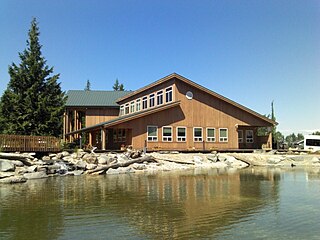
The Squaxin Island Tribe are the descendants of several Lushootseed clans organized under the Squaxin Island Indian Reservation, a Native American tribal government in western Washington state.
Nisqually, Niskwalli, or Nisqualli may refer to:
The Nisqually are a Lushootseed-speaking Native American tribe in western Washington state in the United States. They are a Southern Coast Salish people. They are federally recognized as the Nisqually Indian Tribe, formerly known as the Nisqually Indian Tribe of the Nisqually Reservation and the Confederated Tribes of the Chehalis Reservation.
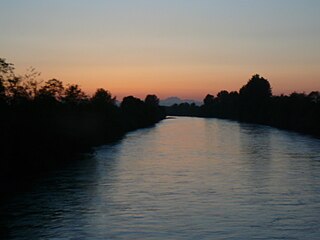
The Puyallup River is a river in the U.S. state of Washington. About 45 miles (72 km) long, it is formed by glaciers on the west side of Mount Rainier. It flows generally northwest, emptying into Commencement Bay, part of Puget Sound. The river and its tributaries drain an area of about 948 square miles (2,460 km2) in Pierce County and southern King County.

The Nisqually River is a river in west central Washington in the United States, approximately 81 miles (130 km) long. It drains part of the Cascade Range southeast of Tacoma, including the southern slope of Mount Rainier, and empties into the southern end of Puget Sound. Its outlet was designated in 1971 as the Nisqually Delta National Natural Landmark.
Puget Sound salmon recovery is a collective effort of federal, state and local authorities and non-profit coalitions of universities, scientists, business and industry aimed at restoring Pacific salmon and anadromous forms of Pacific trout (Oncorhynchus) within the Puget Sound region. The Puget Sound lies within the native range of the Pacific Salmon (Oncorhynchus) and two sea-run forms of Pacific trout, the coastal rainbow trout or steelhead and coastal cutthroat trout. Populations of Oncorhynchus have seen significant declines since the middle of the 19th century due to over fishing, habitat loss, pollution and disease. Salmon species residing in or migrating through the Puget Sound to spawning streams include Chum, Coho, Chinook, Sockeye, and Pink salmon. Pacific salmon require freshwater rivers for spawning and most major tributaries of the Puget Sound have salmon, steelhead and cutthroat trout spawning runs.

Humboldt Bay is a natural bay and a multi-basin, bar-built coastal lagoon located on the rugged North Coast of California, entirely within Humboldt County, United States. It is the largest protected body of water on the West Coast between San Francisco Bay and Puget Sound, the second-largest enclosed bay in California, and the largest port between San Francisco and Coos Bay, Oregon. The largest city adjoining the bay is Eureka, the regional center and county seat of Humboldt County, followed by the city of Arcata. These primary cities, together with adjoining unincorporated communities and several small towns, comprise a Humboldt Bay Area with a total population of nearly 80,000 people. This comprises nearly 60% of the population of Humboldt County. The bay is home to more than 100 plant species, 300 invertebrate species, 100 fish species, and 200 bird species. In addition, the bay and its complex system of marshes and grasses support hundreds of thousands of migrating and local shore birds. Commercially, this second-largest estuary in California is the site of the largest oyster production operations on the West Coast, producing more than half of all oysters farmed in California.
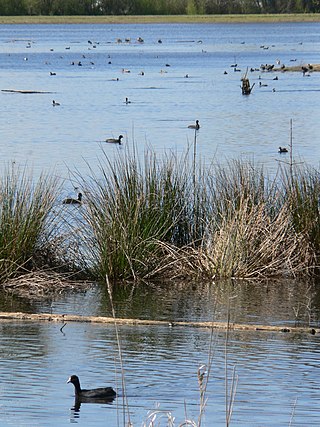
Ankeny National Wildlife Refuge is located in the fertile Willamette Valley of northwestern Oregon, 12 miles (19 km) south of Salem. The valley was once a rich mix of wildlife habitats. Valley wetlands were once extensive, with meandering stream channels and vast seasonal marshes. Today, the valley is a mix of farmland and growing cities, with few areas remaining for wildlife.
The Treaty of Medicine Creek was an 1854 treaty between the United States, and nine tribes and bands of Indians, occupying the lands lying around the head of Puget Sound, Washington, and the adjacent inlets. The tribes listed on the Treaty of Medicine Creek are Nisqually, Puyallup, Steilacoom, Squawskin, S'Homamish, Stehchass, T'Peeksin, Squi-aitl, and Sa-heh-wamish. The treaty was signed on December 26, 1854, by Isaac I. Stevens, governor and superintendent of Indian Affairs of the territory at the time of the signing, along with the chiefs, head-men and delegates of the stated tribes. For the purpose of the treaty, these representatives who signed the treaty were stated to have been, "regarded as one nation, on behalf of said tribes and bands, and duly authorized by them."
The Oregon Coast National Wildlife Refuge Complex consists of six National Wildlife Refuges along the Oregon Coast. It provides wilderness protection to thousands of small islands, rocks, reefs, headlands, marshes, and bays totaling 371 acres spanning 320 miles (515 km) of Oregon's coastline. The areas are all managed by the United States Fish and Wildlife Service.

Bandon Marsh National Wildlife Refuge is a U.S. National Wildlife Refuge on Oregon's coast. It is one of six National Wildlife Refuges comprising the Oregon Coast National Wildlife Refuge Complex and is renowned among bird watchers for being able to view rare shorebirds including ruff, Hudsonian godwit, and Mongolian plover. The refuge was last expanded in 1999, it now has 889 acres (3.60 km2) in two units: Bandon Marsh and Ni-les'tun.

Fir Island is bounded by North and South Forks of the Skagit River and Skagit Bay of Puget Sound in the southwestern corner of Skagit County, Washington. Triangular in outline, 5.3 miles (8.5 km) east–west by 6.5 miles (10.5 km) north–south with an area of nearly 9,900 acres (40 km2), Fir Island is occupied by 195 families. The island is connected by bridge to the village of Conway, located on the east shore of the South Fork of the Skagit River. A second bridge, across the North Fork of the Skagit River, leads to La Conner, 3.7 miles (6.0 km) northwest. Near the northeast tip of Fir Island is the site of the 19th-century town of Skagit City which declined after upstream log jams were removed in 1877.
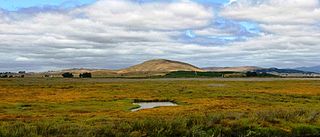
San Pablo Bay National Wildlife Refuge is a 13,190-acre (53.4 km2) National Wildlife Refuge in California established in 1970. It extends along the northern shore of San Pablo Bay, from the mouth of the Petaluma River, to Tolay Creek, Sonoma Creek, and ending at Mare Island.

Billy Frank Jr. was a Native American environmental leader and advocate of treaty rights. As a member of the Nisqually tribe, Frank led a grassroots campaign in the 1960s and 1970s to secure fishing rights on the Nisqually River, located in Washington state. His efforts centered around promoting cooperative management of natural resources. Frank served as the chairman of the Northwest Indian Fisheries Commission for over thirty years.

Located in southwestern Washington and northwestern Oregon, United States, the Julia Butler Hansen Refuge for the Columbian White-Tailed Deer is a wildlife refuge. It was established in 1972 specifically to protect and manage the endangered Columbian white-tailed deer. The refuge contains over 5,600 acres (23 km2) of pastures, forested tidal swamps, brushy woodlots, marshes, and sloughs along the Columbia River in both Washington and Oregon.
The Fish Wars were a series of civil disobedience protests by Native American tribes in the Pacific Northwest region of the United States during the 1960s and 1970s. These protests, coordinated by tribes around the Puget Sound, pressured the U.S. government to recognize fishing rights granted by the Treaty of Medicine Creek. They protested by continuing to fish on their land while risking charges being pressed against them.
Leque Island is a small island located in Snohomish County, in Washington, United States. It can be found just beneath the bridge between Camano Island and Stanwood, at the mouth of the Stillaguamish River, in Puget Sound.

South Puget Sound is the southern reaches of Puget Sound in Southwest Washington, in the United States' Pacific Northwest. It is one of five major basins encompassing the entire Sound, and the shallowest basin, with a mean depth of 37 meters (121 ft). Exact definitions of the region vary: the state's Department of Fish and Wildlife counts all of Puget Sound south of the Tacoma Narrows for fishing regulatory purposes. The same agency counts Mason, Jefferson, Kitsap, Pierce and Thurston Counties for wildlife management. The state's Department of Ecology defines a similar area south of Colvos Passage.
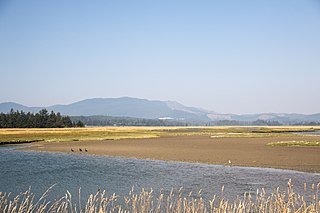
Sitka Sedge State Natural Area is an estuary and beach on the north coast of the U.S. state of Oregon in Tillamook County. Sitka Sedge consists of 357 acres (144 ha) of tidal marsh, mudflats, dunes, forested wetlands, and uplands at the south end of the Sand Lake estuary, north of Tierra Del Mar.















